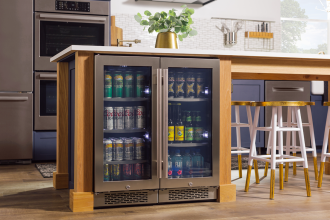A hybrid office model helps create a workspace that promotes productivity, flexibility, and collaboration. The office model encourages employees to maintain a work-life balance by combining in-office and remote work. According to statistics, around 64% of leaders choose a hybrid office model for their organization.
However, an organization needs a comprehensive office lighting system to ensure the well-being of the employees and to create a welcoming atmosphere in a hybrid office. Lighting plays a crucial role in creating a comfortable, productive, and adaptable environment.
Understanding The Needs of A Hybrid Office
Diverse Work Styles
A hybrid office accommodates different work styles, blending collaboration zones with focused work areas. Therefore, hybrid offices require flexible light solutions such as an LED linear suspension light system to create an environment that supports both interaction and concentration.
Open spaces for teamwork need bright, evenly distributed illumination, whereas private workstations require task lighting to enhance concentration and boost productivity. Installing linear suspension lights provides consistent lighting for shared and individual spaces. These lights can also be adjusted to accommodate flexible seating and multifunctional areas, ensuring optimal visibility and comfort.
Adaptability
A well-designed hybrid office requires lighting systems that adapt to different tasks and work modes. Adjustable lighting helps create the right atmosphere for brainstorming sessions, meetings, and individual work. By incorporating both ambient and task-specific lighting, such as dimmable LED linear suspension lights, you can maximize the comfort and efficiency of your workspace.
Wellness and Productivity
Lighting directly affects circadian rhythms, mental health, and overall well-being of employees. Inadequate lighting can cause eye strain and fatigue and also decrease productivity. Therefore, a hybrid office should use lighting that mimics natural daylight to promote alertness during work hours.
Choosing a dynamic lighting solution, such as LED linear suspension lighting with adjustable brightness and color temperature, can help reduce eye strain and create a healthier work environment. With a thoughtfully designed lighting solution, a hybrid office will enjoy a more energized and focused workforce.
Key Office Lighting Design Considerations
When designing a lighting system for a hybrid office, you should consider some key factors such as:
Layered Lighting
Layered lighting involves using a combination of different lighting types to meet various needs. For example:
- Ambient lighting provides uniform, base-level illumination across the office. These lights ensure a well-lit environment, creating a comfortable foundation for other types of lighting fixtures.
- Then comes task lighting, which focuses on specific areas like desks and meeting spaces. These lights offer target illumination for detailed work.
- Accent lighting is used to add visual interest and highlight architectural features.
Together, these layers create a versatile lighting setup that enhances both productivity and ambiance.
Color Temperature
Color temperature plays a significant role in setting the tone for different work areas. For example:
- Cool white light (4000–5000K) is ideal for areas where you need focus and productivity, such as desks and meeting rooms.
- Warm white light (2700–3500K) is perfect for relaxation zones and casual meeting spaces. It gives your office a warm and inviting atmosphere.
- Dynamic lighting systems, such as a linear suspension light with smart control features, allow for color temperature adjustments throughout the day. This enables employees to adjust the lighting according to their needs and preferences.
Brightness Levels (Lumens)
Brightness is measured in lumens, and a hybrid office must strike the right balance to create a well-lit and comfortable environment.
General office lighting should range from 300–500 lumens per square meter, offering sufficient light for most tasks. As for task areas, such as desks, 400–800 lumens per square meter are ideal for focused work. However, it is essential to avoid over-lighting, as this can lead to glare and energy waste.
Glare Control
Glare can cause eye strain, which eventually affects productivity, which is why controlling glare in a hybrid office is extremely important. Using diffusers and anti-glare coatings on fixtures can soften light and reduce harsh reflections. Additionally, strategically placing light fixtures helps minimize glare on screens, improve visual comfort, and increase focus.
Natural Light Integration
Natural light has numerous benefits for well-being and productivity. Maximizing daylight through open layouts and proper window placement can make the workspace feel more inviting and connected to the outside.
Moreover, balancing artificial and natural light ensures a consistent, well-lit environment throughout the day. Allowing natural light into the office reduces the need for excessive artificial lighting, eliminates the need for additional fixtures, and even lowers energy consumption.
Ledia Lighting: Perfect Solution for Hybrid Offices
Looking for the perfect linear LED lighting solution for your hybrid office?
Check out LEDIA Lighting latest series of linear LED lights that are specifically designed to meet the unique needs of modern, flexible workspaces. LEDIA lighting linear LED lights provide an ideal balance of brightness and energy efficiency, creating a dynamic and adaptable lighting environment for hybrid offices.













